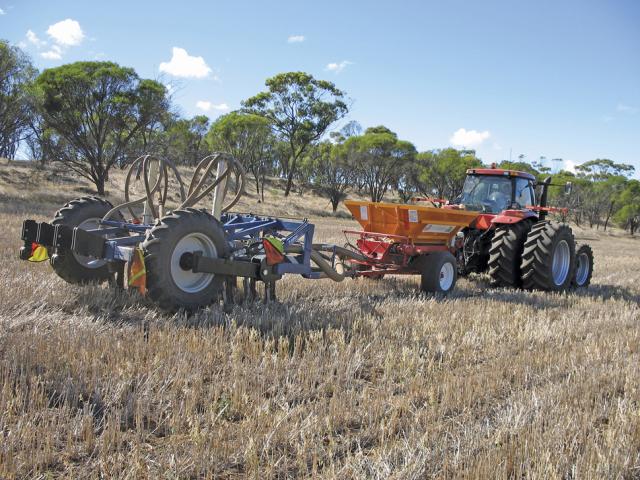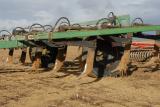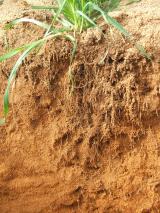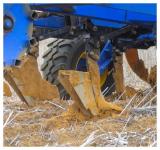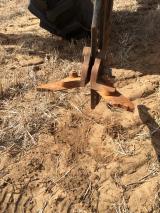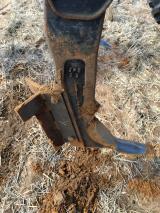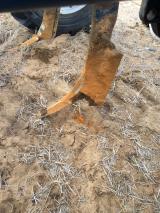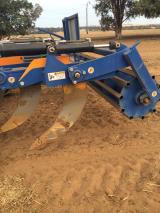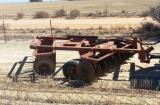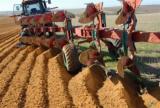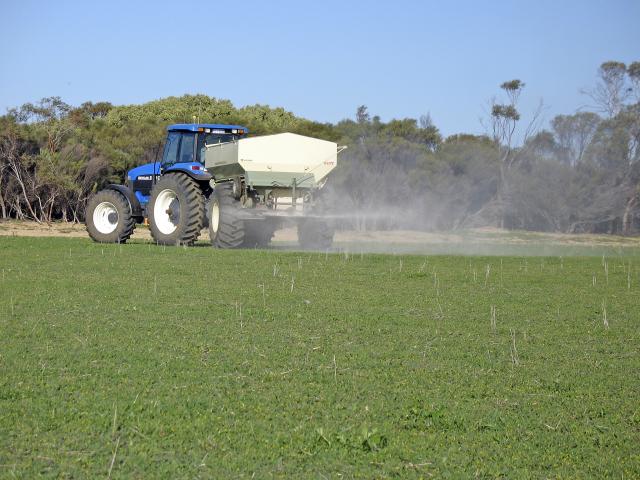Liming techniques
Whether liming to maintain or recover soil pH, surface application (at appropriate rates) is currently the recommended method for most situations (Figure 1). In time, sufficient surface application of lime will treat subsurface acidity.
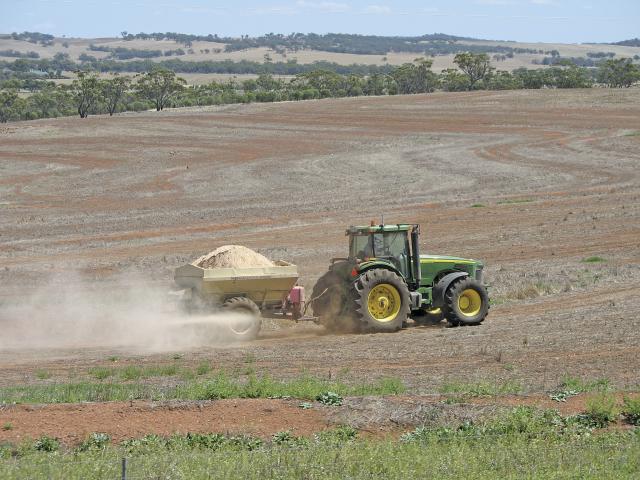
Recently, incorporation of lime into the soil by mouldboard ploughing or rotary spading has shown promising results and can, if done appropriately, recover acidic subsurface soil to target pH rapidly. Rotary spading generally achieves a better distribution of lime through the soil profile than mouldboard ploughing, which buries the lime with the topsoil, leaving an acidic layer on the surface.
If you are ploughing or spading to remove another constraint, then it is worth considering the opportunity to incorporate lime to treat subsurface acidity. The risks, costs and returns need to be carefully evaluated before undertaking an expensive process such as ploughing or spading just to incorporate lime for quick recovery of acidic subsurface soil.
Good results have been achieved with deep placement of lime by direct injection using modified farm-scale machinery (Figure 2), but it is difficult and time-consuming to achieve the desired distribution, and ineffective and expensive if it is not achieved. Deep placement is only recommended for soils in which subsurface acidity is constraining production and, before it is attempted, detailed consideration should be given to whether it is likely to be profitable.
Surface application
The main aim when applying lime to the surface should be an even coverage of the ground. The spreading width should be approximately 6-8 metres (m) (depending on wind conditions) to get good coverage of fine particles (less than 0.5 millimetres (mm)). Spreading too wide results in uneven treatment of soil acidity. Larger particles will spread up to 15m but the effective distribution is poor and will result in variable change in pH.
Surface applied then deep-rip
It is good practice when applying lime to spread the lime prior to any soil disturbance such as deep-ripping, ploughing or spading. This enables better distribution of the lime particles and greater contact with the acidic soil. Liming before deep-ripping for compaction adds value to both treatments.
Direct injection
This technique deep-places lime during deep-ripping, using modified machinery (Figure 2). Research has shown that successful direct injection is possible (Figure 3 right) and subsurface acidity can be quickly removed as a production constraint. When the distribution of lime is correct, yield responses of 20-30% in wheat are common.
However, increased costs due to machinery modification and slow operation need to be considered. It is difficult to achieve adequate distribution of the lime. Poor distribution can result in the lime being placed below an untreated acidic layer (Figure 3, left), which continues to act as a barrier to root growth. Only where compaction is also a constraint, may direct injection be worth considering.
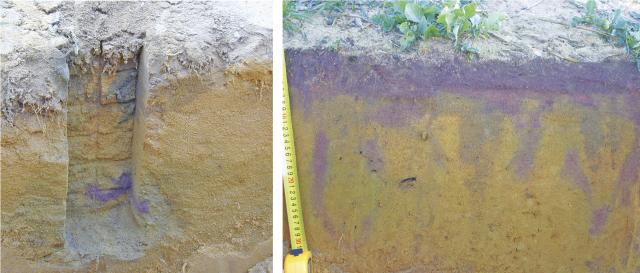
Mouldboard ploughing
Mouldboard ploughing is usually done to fully invert the soil profile, which can result in very effective weed seed burial, typically achieving weed control in excess of 90%. For lime incorporation, however, some mixing and distribution of the lime through the profile is needed to provide a continuous ameliorated pH pathway from the surface soil into the subsoil for root growth.
Soil inversion using mouldboard plough typically results in the lime being buried in a layer at depth together with the topsoil, above which is a layer of acidic soil brought up from the subsurface. Even if the soil is then limed, it can still take some time for this lime to ameliorate the acidic subsurface soil that is now at the surface creating a barrier to root growth.
Figure 4 shows an example of where mouldboard ploughing achieved excellent inversion but a thick layer of very acidic subsurface soil (pHCa=3.8-4.2) was brought to the surface and despite lime applications before and after ploughing, crop root growth is still being severely restricted by the acidic layer that is sitting above the buried topsoil.
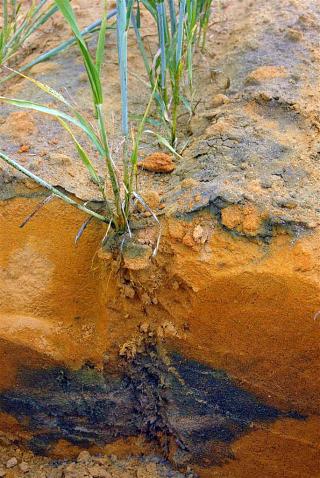
Keeping the mouldboard plough working a little shallower, using a higher speed and setting it up to get incomplete inversion may result in the formation of an angled limed topsoil layer that goes from the surface to subsurface and provides a pathway for root growth into the subsoil. This will compromise weed control and the value of this approach to incorporate lime needs to be weighed up against the costs and compared to other incorporation methods such as rotary spading.
Mouldboard ploughing has proven to be successful for incorporating lime in sandplain soils with mild to moderate subsurface acidity but should be used with caution in more strongly acidic soils.
Rotary spading
Rotary spading is a very effective method for deep incorporation of lime to depths of 30-35 centimetres (cm). The spades bury some topsoil while also lifting seams of subsoil to the surface. While the mixing is not thorough or even throughout the profile there is good distribution of lime right through the cultivation depth with many areas of higher pH where the lime has been mixed into the subsoil (Figure 5).
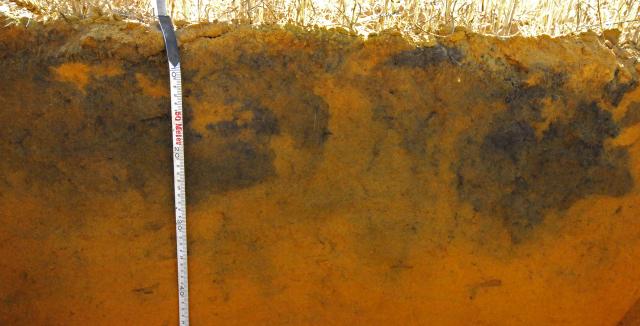
This mixing action will also improve the contact of the lime with the acidic soil resulting in more rapid and effective neutralisation of the acidity in the soil. Because lime is mixed through a greater volume of acidic soil, higher rates of lime may need to be applied for effective neutralisation of the acidity and the opportunity for lime to move below the cultivation depth.
Usually it is recommended to take the opportunity to incorporate lime when you are spading to ameliorate non-wetting soil rather than to undertake spading for lime incorporation alone. In soils with an extremely acidic profile, spading may be the only realistic option for recovering the pH to reasonable levels. Careful consideration of the costs and benefits need to be undertaken to assess whether or not this would be a cost effective option.
Shallow incorporation
Some farmers use shallow incorporation of 200-300 kilograms per hectare (kg p/ha) of lime at seeding. This may be a convenient way to fit maintenance liming into the farming schedule. Soil testing should be done every few years to ensure sufficient lime is being applied to maintain topsoil pHCa at or above 5.5. Department of Primary Industries and Regional Development research shows that low rates of lime that do not maintain the surface pHCa at 5.5 or above are insufficient to treat ongoing subsurface acidification. This would not be an effective method of recovering acidic soil as insufficient lime is applied.
Shallow incorporation of appropriate rates of lime using offset discs can be beneficial. The cost is 70-80% cheaper than for rotary spading, although the incorporation depth is only 10-12cm. The advantage over surface application is the mixing and faster neutralisation, leading to more opportunity for the lime to then move deeper into the profile (Figure 6).
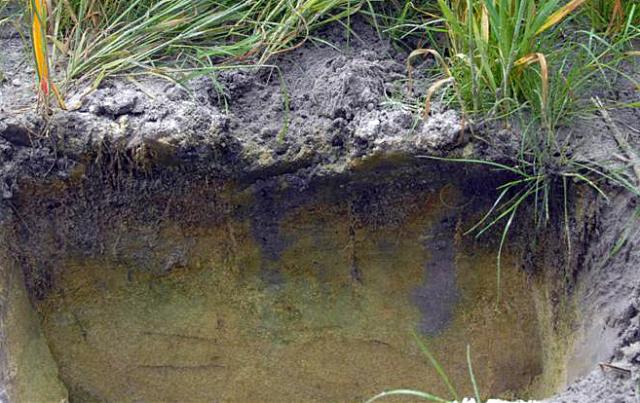
Efficacy and cost of incorporating lime
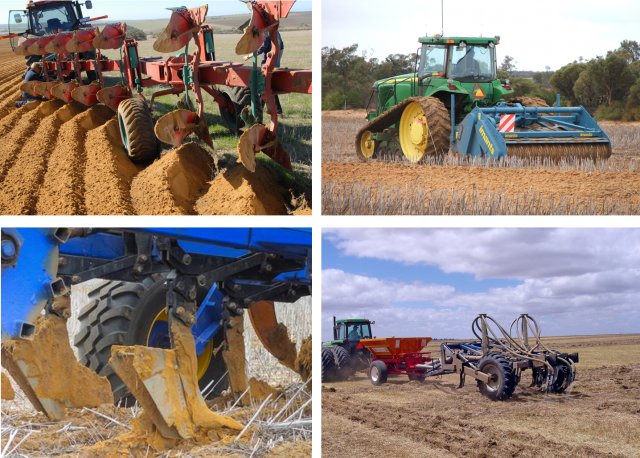
The efficacy with which various implements can incorporate surface applied lime depends on numerous factors including:
- Soil type, in particular clay content, which can affect the cohesion, fracturing and flow of the soil.
- Soil moisture conditions - in sandplain soils moisture can help the sand maintain its form (greater cohesion) allowing slots to remain open for longer but may reduce fracturing and soil flow. Wetter soils are softer so this can improve the penetration of soil by implements and reduce draft. Dry surface sand flows easier when worked (less cohesion) which can be an advantage for moving limed topsoil behind soil openers. Optimal movement probably occurs when there is some subsoil moisture but the limed topsoil is dry and can readily flow into the fractured subsoil.
- Implement type - variations between machinery brands such as width of tines, curved or laid-back tines which may promote a lifting (delving) action; curvature (dish depth) of discs are just some examples.
- Implement set up and use - for disc ploughs and mouldboard ploughs setup greatly influences the incorporation result. Having ploughs more open will increase the work rate and the space between ploughshares available for soil to move but may limit the working depth.
- Speed of operation - higher speeds can result in more soil throw and mixing but may require a shallower working depth.
The table below gives a brief description of various tillage implements, the mixing action of each implement, typical working depth and some supplementary information on the efficacy of lime incorporation. Note that every situation is different and this information is designed to be used simply as a guide when considering options for incorporating lime.
Timing of liming
It is sometimes difficult to fit liming into an already busy schedule. Most liming is carried out in autumn after summer soil testing results have been analysed. While there is some benefit of incorporation during sowing or working-in by stock of lime applied earlier, if time is a constraint, liming at other times should be considered.
Spring liming is a good option for pasture and allows the workload to be spread (Figure 7). Soil microbes responsible for the breakdown of soil organic matter and mineralisation of nitrogen are inhibited by acidic soil (Soil microbial activity). Liming in spring allows benefit from the warm, moist conditions, which favour microbial activity. Spring liming of pastures allows time for the lime to start neutralising soil acidity before a cropping rotation, particularly if there is summer rainfall.
With tramline farming systems, lime can be applied at any time without any detriment to the crop.


